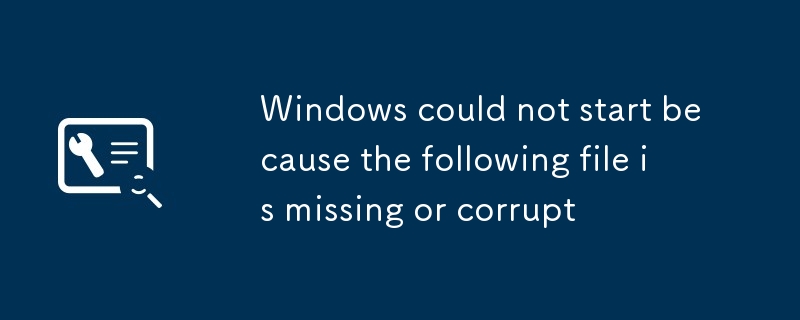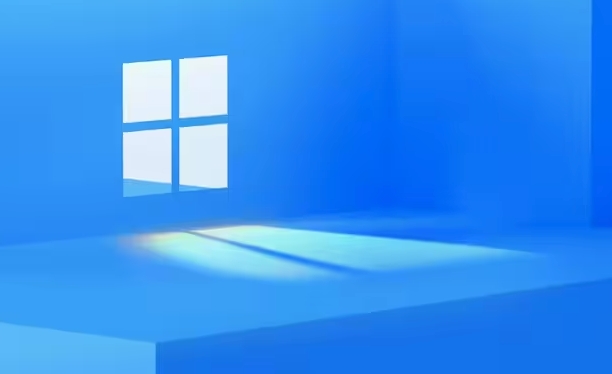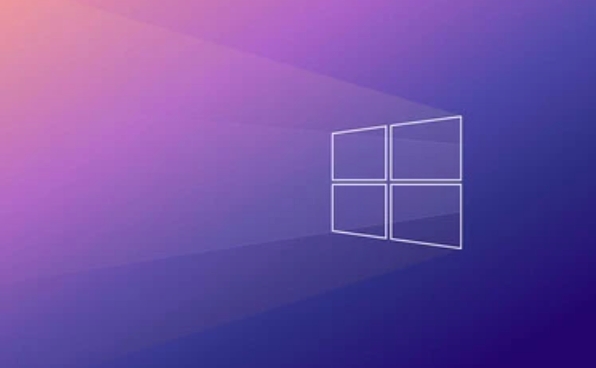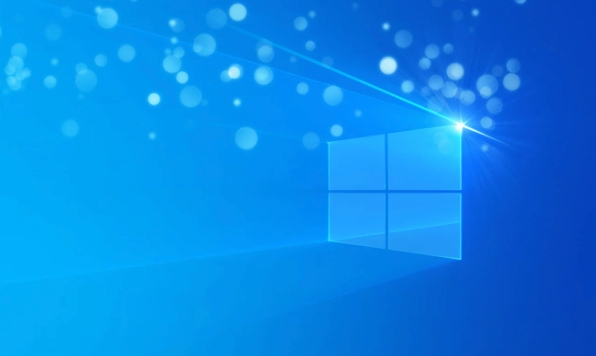 Computer Tutorials
Computer Tutorials
 Troubleshooting
Troubleshooting
 Windows could not start because the following file is missing or corrupt
Windows could not start because the following file is missing or corrupt
Windows could not start because the following file is missing or corrupt
Jul 07, 2025 am 02:39 AMWhen the boot prompt is "Windows could not start because the following file is missing or corrupt", 1. You can run bootrec /fixmbr, bootrec /fixboot, bootrec /rebuildbcd through the Windows installation media; 2. Check the hard disk connection or use CrystalDiskInfo to detect the health status of the hard disk; 3. If there is a dual system, you can use the bootrec command to rebuild the boot or manually add the boot items; 4. Use PE environment to kill viruses and combine DISM and SFC tools to repair the system files, and in most cases, the system boot can be restored.

When you boot up, you encounter the prompt "Windows could not start because the following file is missing or corrupt". You can basically confirm that there is a problem with the system boot file. Don't panic. Although this situation seems scary, it can be fixed most of the time through some basic operations.

Here are some common reasons and corresponding solutions that can help you determine where to start:

1. System files are corrupt or lost
The most common reasons for this problem are that critical system startup files (such as ntoskrnl.exe or other core system files) are corrupted, lost, or disks have bad channels, resulting in failed reading.
You can try:

- Insert the Windows installation USB disk or CD and enter "Repair Computer"
- Go to "Troubleshooting → Advanced Options → Command Prompt"
- Execute the following command:
-
bootrec /fixmbr -
bootrec /fixboot -
bootrec /rebuildbcd
-
These commands attempt to repair the main boot record, boot sector, and rebuild the BCD (boot configuration data).
2. Hard disk connection or hardware problems
Sometimes it is not because the system itself is broken, but because the hard disk is poorly contacted, the SATA cable is loose, and even the hard disk begins to age and there are bad blocks.
Suggested troubleshooting steps:
- Re-plug and unplug the hard drive cable after shutdown
- Try changing to a SATA interface
- If it is an SSD, check whether it can still be recognized in the BIOS
- Use tools to check the health status of the hard disk (such as CrystalDiskInfo)
Especially for desktop users, this kind of physical connection problem is not uncommon, and it is much more reliable to check it out manually than guessing it.
3. Dual system boot conflict (if you have Linux or multiple Windows versions installed)
If you have installed dual systems before, especially Linux, GRUB boot may overwrite Windows boot, or the boot information is inconsistent after updating the system.
Solution:
- Enter the command prompt using Windows installation media
- Run the bootrec command mentioned above again
- If the system is not recognized, you may need to manually add a boot item
This situation often occurs in users who are struggling with the system, and it is not difficult to repair, but you just have to be a little patient.
4. Boot damage caused by viruses or abnormal shutdown
Sudden power outage, forced shutdown, or hitting certain malware may also damage the system boot files.
Coping strategies:
- Scan the hard disk for viruses in PE environment
- Try using DISM tool for system image repair
-
DISM /Image:C:\ /Cleanup-Image /RestoreHealth
-
- Then run SFC scan (even if you can't enter the system, you can mount the mirror to process it)
This kind of situation is relatively rare, but once it occurs, it is necessary to pay attention to backup and anti-virus.
Basically, these common reasons and corresponding operations. When encountering this error, don’t rush to reinstall the system. Check it in order first. In most cases, you can save it. If all the above methods have not been done yet, you may have to consider whether there is a problem with the hard disk or reinstalling the system.
The above is the detailed content of Windows could not start because the following file is missing or corrupt. For more information, please follow other related articles on the PHP Chinese website!

Hot AI Tools

Undress AI Tool
Undress images for free

Undresser.AI Undress
AI-powered app for creating realistic nude photos

AI Clothes Remover
Online AI tool for removing clothes from photos.

Clothoff.io
AI clothes remover

Video Face Swap
Swap faces in any video effortlessly with our completely free AI face swap tool!

Hot Article

Hot Tools

Notepad++7.3.1
Easy-to-use and free code editor

SublimeText3 Chinese version
Chinese version, very easy to use

Zend Studio 13.0.1
Powerful PHP integrated development environment

Dreamweaver CS6
Visual web development tools

SublimeText3 Mac version
God-level code editing software (SublimeText3)
 How to change the system display language for all users in Windows
Jul 31, 2025 am 08:18 AM
How to change the system display language for all users in Windows
Jul 31, 2025 am 08:18 AM
InstallthedesiredlanguagepackviaSettings→Time&Language→Language®ion,ensuring"SetasmyWindowsdisplaylanguage"isselected.2.Changethesystemdisplaylanguageinthesamemenuandrestart.3.OpenControlPanel→Region→Administrativetab,click"
 How to reset the Microsoft Store in Windows
Jul 31, 2025 am 08:23 AM
How to reset the Microsoft Store in Windows
Jul 31, 2025 am 08:23 AM
ResettheMicrosoftStoreviaSettingsbygoingtoApps>Installedapps,selectingMicrosoftStore,clickingAdvancedoptions,thenRepairandResetifneeded.2.Ifthatfails,re-registertheStoreusingPowerShellasadminwiththecommand:Get-AppXPackage-NameMicrosoft.WindowsStor
 How to install Windows on a Mac without Boot Camp
Jul 31, 2025 am 11:58 AM
How to install Windows on a Mac without Boot Camp
Jul 31, 2025 am 11:58 AM
Without BootCamp, installing Windows on Mac is feasible and works for different chips and needs. 1. First check compatibility: The M1/M2 chip Mac cannot use BootCamp, it is recommended to use virtualization tools; the Intel chip Mac can manually create a boot USB disk and install it in partition. 2. Recommended to use virtual machines (VMs) for M1 and above chip users: Windows ISO files, virtualization software (such as ParallelsDesktop or UTM), at least 64GB of free space, and reasonably allocate resources. 3. IntelMac users can manually install it by booting the USB drive: USB drive, WindowsISO, DiskU is required
 How to reset the TCP/IP stack in Windows
Aug 02, 2025 pm 01:25 PM
How to reset the TCP/IP stack in Windows
Aug 02, 2025 pm 01:25 PM
ToresolvenetworkconnectivityissuesinWindows,resettheTCP/IPstackbyfirstopeningCommandPromptasAdministrator,thenrunningthecommandnetshintipreset,andfinallyrestartingyourcomputertoapplychanges;ifissuespersist,optionallyrunnetshwinsockresetandrebootagain
 How to install Windows on a Mac
Jul 31, 2025 am 10:07 AM
How to install Windows on a Mac
Jul 31, 2025 am 10:07 AM
ForIntel-basedMacs,useBootCampAssistanttocreateadual-bootsystemwithWindowsbypreparingaUSBdrive,downloadingaWindowsISO,partitioningthedisk,andinstallingWindowsalongsidemacOSwithsupportdrivers.2.ForAppleSiliconMacs(M1/M2/M3),usevirtualizationsoftwareli
 Step-by-step guide to installing Windows from an ISO file
Aug 01, 2025 am 01:10 AM
Step-by-step guide to installing Windows from an ISO file
Aug 01, 2025 am 01:10 AM
DownloadtheWindowsISOfromMicrosoft’sofficialsite.2.CreateabootableUSBusingMediaCreationToolorRufuswithaUSBdriveofatleast8GB.3.BootfromtheUSBbyaccessingthebootmenuoradjustingBIOS/UEFIsettings.4.InstallWindowsbyselectingcustominstallation,choosingtheco
 A guide to custom Windows installation options
Aug 01, 2025 am 04:48 AM
A guide to custom Windows installation options
Aug 01, 2025 am 04:48 AM
Choose"Custom:InstallWindowsonly(advanced)"forfullcontrol,asitallowsacleaninstallthatremovesoldissuesandoptimizesperformance.2.Duringsetup,managepartitionsbydeletingoldones(afterbackingupdata),creatingnewpartitions,formatting(usingNTFS),ors
 How to manage AppLocker policies in Windows
Aug 02, 2025 am 12:13 AM
How to manage AppLocker policies in Windows
Aug 02, 2025 am 12:13 AM
EnableAppLockerviaGroupPolicybyopeninggpedit.msc,navigatingtoApplicationControlPolicies,creatingdefaultrules,andconfiguringruletypes;2.Createcustomrulesusingpublisher,path,orhashconditions,preferringpublisherrulesforsecurityandflexibility;3.Testrules





